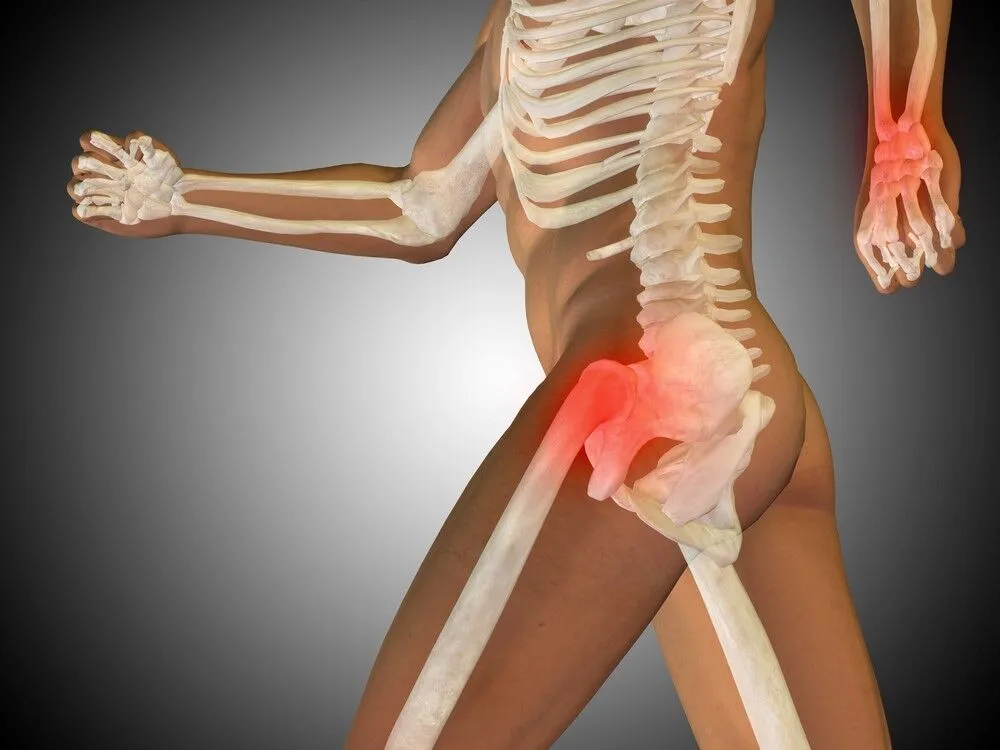One of the many consequences of menopausal estrogen loss is a change in our tendons. But could hormone treatment make a difference?
The tendons most often affected are in our hips and shoulders — the big, hard-working joints with lots of tendon attachments.
Tendons are tough and fibrous and connect muscle to bone. They don’t have much blood supply, so healing is slow.
The research on hormones and tendon — not that there’s much of it — has largely focused on the hip tendons and a condition called gluteal tendinopathy.
‘Gluteal’ refers to a group of three muscles that make up our buttocks and the sides of our hips. They stabilise and control the movement of our lower body.
In the case of gluteal tendinopathy (let’s call it GT for short), the problem tendons are the side-of-the-hip ones. They hurt, especially in activities such as lying on the affected hip or walking up stairs.
It’s estimated that one in four of us has this, and it’s often hard to pinpoint the exact cause or combination of causes in each woman who’s affected.
There might be a genetic factor in relation to collagen or tendon structure. GT can also reflect weakness of the hip muscles, hip instability, or overloading of the area, and there’s a possible link to lifestyle habits such as leg crossing.
For all that, menopause seems to be a trigger. Tendons are mostly made up of collagen, and less estrogen in our bloodstream is linked with less collagen production, smaller collagen fibres, a change in fibre arrangement, and weaker tendons that no longer repair themselves as well as they used to.
Menopause doesn’t occur in isolation though. It goes hand-in-hand with ageing, and some researchers have suggested that with age we also have fewer stem cells to help with tendon repair.
So we’re probably dealing with an interplay of the two, and if we add in those other possible factors (genes, exercise, and so on) it can be complicated.
At this point the most effective treatment for GT is exercise that gradually strengthens the hip muscles and tendons, plus avoiding the kinds of lifestyle habits that can upset them.
As well as building strength, exercise can improve collagen replacement and fibre size and re-organise the arrangement of collagen fibres.
I’ve mentioned leg crossing as a habit, but others are sleeping on our side with the top leg stretched across the bottom one (similar to sitting with legs crossed) and standing slumped onto one hip.
Hip pain or not, it’s wise to avoid these three positions because they put pressure on the tendons. If you like to sleep on your side put a pillow under your top leg.
So given the probable role of estrogen in this, what about hormone therapy? Could it help prevent these issues in the first place, or aid recovery for women dealing with GT or other tendon complaints? After all, it’s been shown to be useful for bone density.
What I’m about to tell you feels like a broken record because I’ve written about the role of hormone therapy in various women’s health conditions in the past.
We don’t know. Researchers have concluded that their results are ‘conflicting and contradictory’, and that’s likely to be because we get into messy areas such as dosages and routes of administration (e.g. topical cream vs oral).
And as anyone who’s had conversation with doctors about hormone therapy will know, there can be lots of ifs, buts and maybes. And if we’re over 60 most doctors won’t consider it.
The research doesn’t rule it out; there’s just no consistent evidence as to how to use it in such a way that it makes a difference over and above exercise.
Women grappling with tendon issues might also wonder whether supplementing with collagen could help. After all, tendons are largely collagen.
Unfortunately, there’s no evidence for this either. Collagen, while it’s the main component of tendon, isn’t the only one. I’ve mentioned the possible role of stem cells, but there are other growth factors involved too.
In addition, it’s not just a loss of collagen that takes place. One of the features of tendinopathy is a change in the way the fibres are laid down.
For now, targeted exercise, along with lifestyle habit changes is the best prescription we have.
Photo Source: the osteopath.net.au

